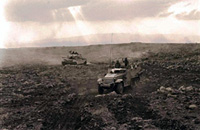|
|

Yom Kippur War |

|
| |
On October 6, 1973, Yom Kippur (the Day of Atonement), the holiest day on the Jewish religious calendar, Egypt and Syria took advantage of optimal circumstances to launch attacks that took Israel by surprise. So complete was the element of surprise that when war erupted, Israel was only beginning to mobilize the reserve forces which form the bulk of the IDF. The thin forces stationed along the two fronts had to contain the invading armies until the IDF was prepared to meet them in force. The IAF was hampered by the dense anti-aircraft missile system which the enemy had deployed close to the front.
Egyptian forces succeeded in crossing the Canal and establishing beachheads on the Israeli-held east bank. On the Golan Heights, the Syrians pushed past the cease-fire lines and occupied a large area. They also seized the key Israeli intelligence- gathering position high on Mt. Hermon. |
| |
Within two days, the IDF, now fully deployed, blocked the Egyptian and Syrian advances and took the offensive. Because of the huge quantitative superiority of the Syrian forces, a situation compounded by the proximity of Jewish settlements on the Syrians' path of advance, it was decided to give priority to the northern front. By October 10, the Syrians had been pushed back and the entire Golan was again in Israeli hands, except for the Hermon position, which was only recaptured toward the end of the war. Between October 11 and October 14, the IDF pushed the Syrian forces across the cease-fire lines and penetrated Syrian territory. An Iraqi expeditionary force dispatched to reinforce the Syrians was also successfully blocked. |
 |
|
| |
On the southern front, an early Israeli counter-offensive failed. But Israeli units managed to overcome an attack by Egyptian tank forces, destroying 200 enemy tanks in the process. Shortly afterward, on 15 October, the IDF renewed the counter-offensive. The main thrust of the fighting now was to push across the Canal and strike at Egyptian forces on the other side. |
| |
A gap between the Egyptian 2nd and 3rd Armies was chosen as the crossing point. It was a difficult operation, preceded by heavy fighting to clear the approach lines. The Engineering Corps constructed a bridge across the Canal in the face of concerted Egyptian resistance. By October 19, Israeli troops were well established on the west bank. Until the first scheduled cease-fire on October 22, the IDF enlarged the territory under its control. Although the Egyptians had agreed to the cease-fire, it did not take effect at the designated time. By the time an effective cease-fire was actually implemented, on October 24, the IDF had completely surrounded the Egyptian 3rd Army. |
 |
|
| |
On the northern front, the IDF regained control of the Hermon by October 22, removing the last Syrian forces from the area they had seized at the start of the war. The war ended on October 24 in a decisive victory for the Israeli Army. In the north, the Syrians failed to achieve any territorial gain, while the IDF had crossed the old cease-fire lines into Syrian territory, acquiring new vantage points on the Golan. The Syrian Army suffered major losses of manpower and equipment. |
 |
|
| |
|
|
Lessons of the War |
| |
In the first months after the war, Egyptian and Syrian forces renewed the War of Attrition along the cease-fire lines. The IDF focused on building its force on an unprecedented scale. The enemy attempted to prevent the IDF from conducting a war of movement dominated by tank and air power. Arab armies made extensive use of infantry equipped with anti-tank weapons, exploiting their inherent numerical superiority. In response, the IDF took steps to upgrade and increase its manpower utilization. Extensive and intensive training programs were initiated, focusing on the doctrine of combined operations in which the various branches of the IDF were integrated in a harmonious whole.
A special central training base was established to advance this doctrine. Another lesson of the war was a renewed awareness of the importance of the Infantry. Rearmament continued apace, including the purchase of ground-to-ground and ground-to-air missile systems. |
 |